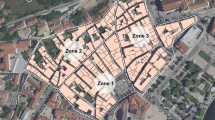Abstract
Only recently seismic prevention has come up in urban planning and considered as a significant part of the social capital of the urban heritage. Among the planning tools for reducing the vulnerability of urban fabrics, the Emergency Limit Condition (ELC) defines the fields which require widespread strengthening interventions in the buildings involved in resilient town units. The extent and intensity of such interventions can be graded so as to find an optimal ELC measure, taking the needs of the urban and human capital into account. In case of the old town centre of Ragusa, a model for analysing the seismic vulnerability of the built-up areas has been integrated with a model for a cost-revenue estimation in order to identify the conditions of the ELC dimensioning and to develop the relevant incentive system.
Access this chapter
Tax calculation will be finalised at checkout
Purchases are for personal use only
Preview
Unable to display preview. Download preview PDF.
Similar content being viewed by others
References
Bonafede, G., Napoli, G.: Multicultural Palermo between gentrification and real estate market crisis in: the historical center. In: From control to co-evolution. AESOP Annual congress 9-12 July 2014 Procedeengs, Utrecht/Delft: AESOP, pp.1-12 (2014)
Boulle, P.: Vulnerability Reduction for Sustainable Urban Development. Journal of Contingencies and Crisis Management, 179–188 (1997)
Carocci, C.F.: La lettura critica del costruito dei centri storici. In: Rischio sismico, territorio e centri storici, Atti del Convegno Nazionale, Sanremo (IM) 2-3 luglio 2004, pp. 257-262. FrancoAngeli, Milano (2005)
Carocci, C., Copani, P., Marchetti, L., Tocci C.: Vulnerability reduction procedures in ordinary urban management. The Urban Building Code of Faenza, Smart Built (2014)
Carreno, M.L., Cardona, O., Barbat, A.H.: Urban Seismic Risk Evaluation: A Holistic Approach. Natural Hazard 40, 137–172 (2007)
Comune di Ragusa, Piano di Protezione Civile, Ragusa (2012)
Dolce, M., Di Pasquale, G., Speranza, E., et al.: A multipurpose method for seismic vulnerability assessment of urban areas. In: Proceedings of the 15th World Conference on Eathquake Engineering (WCEE), Lisboa (2012)
Dolce, M., Speranza, E., Negra, R.D.: Constructive features and seismic vulnerability of historic centers through the rapid assessment of historic building stocks. The experience of Ferrara, Italy. In: Toniolo, L., et al. (eds.) Built Heritage: Monitoring Conservation Management, Research for Development, pp. 165–175. Fondazione Politecnico di Milano, Milano (2015). doi:10.1007/978-3-319-08533-3_14
Hizbaron, D.R., Baiquni, M., Sartohadi, J., Rijanta, R.: Integration method of disaster risk reduction into spatial planning: case study yogyakarta special province and bantul regency. In: Proceedings of the 1st International Conference on Sustainable Built Environment, Yogyakarta, Indonesia, 4 May 2010; Faculty of Civil Engineering and Planning, pp. 311–321. Islamic University of Indonesia, Yogyakarta (2010)
Hizbaron, D.R., Baiquni, M., Sartohadi, J., Rijanta, R.: Urban Vulnerability in Bantul District, Indonesia - Towards Safer and Sustainable Development. Sustainability 4, 2022–2037 (2012)
Hung, H.C., Ho, M.C., Chien, C.Y.: Integrating long-term seismic risk changes into improving emergency response and land use planning: a case study for the Hsinchu City Taiwan. Natural Hazard 69(1), 491–508 (2013)
Luhmann, N.: Soziologie des Risikos. Walter de Gruyter Co., Berlin (1991)
Luhmann, N.: Social Systems. Stanford University Press, Stanford (1996)
Merchler, R.: Cost-benefit Analysis of Natural Disaster Risk Management in Developing Countries. GTZ (German Society for Technical Cooperation, Eschborn (2005)
Mileti, D.S., Gailus, J.L.: Sustainable development and hazards mitigation in the United States: Disaster by design revisited. Mitig. Adapt. Strateg. Global Chang. 10, 491–504 (2005)
Napoli, G., Schilleci, F.: An Application of Analytic Network Process in the Planning Process: The Case of an Urban Transformation in Palermo (Italy). In: Murgante, B., et al. (eds.) ICCSA 2014. LNCS, vol. 8581, pp. 300–314. Springer, Heidelberg (2014)
Pelling, M.: The Vulnerability of Cities: Natural Disasters and Social Resilience. Earthscan Publishing, London (2003)
Rizzo, F.: Conservazione e Valutazione del patrimonio architettonico-ambientale nelle aree urbane a rischio sismico. Genio Rurale, 9, Bologna (2000)
Rizzo, F.: Il capitale sociale della città. FrancoAngeli, Milano (2003)
Sarris, A., Loupasakis, C., Soupios, P., Trigkas, V., Vallianatos, F.: Earthquake vulnerability and seismic risk assessment of urban areas in high seismic regions: Application to chania city, Crete Island Greece. Nat. Hazards 54, 395–412 (2010)
Sawada, Y.: The Economic Impact of Eartkquake on Households. In: Guha-Sapir, D., Santos, I. (eds.) The Economic Impact of Natural Disasters. Oxford University Press, New York (2013)
Tiedemann, H.: Earthquake and Volcanic Eruptions – A Handbook on Risk Assessment. Swiss Reinsurance Company, Zurich (1992)
Tocci, C.: Vulnerabilità sismica e scenari di danno: analisi speditiva delle catene di danno. In: Blasi, C. (ed.) Architettura storica e terremoti. Protocolli operativi per la conoscenza e la tutela, pp. 113–119. Wolkers Kluwer, Italia (2014)
Yong, C., Ling, C., Guendel, F., Kulhànek, O.: Seismic hazard and loss estimation for Central America. Nat Hazards 25(2), 161–175 (2002)
Author information
Authors and Affiliations
Corresponding author
Editor information
Editors and Affiliations
Rights and permissions
Copyright information
© 2015 Springer International Publishing Switzerland
About this paper
Cite this paper
Giuffrida, S., Ferluga, G., Ventura, V. (2015). Planning Seismic Damage Prevention in the Old Tows Value and Evaluation Matters. In: Gervasi, O., et al. Computational Science and Its Applications -- ICCSA 2015. ICCSA 2015. Lecture Notes in Computer Science(), vol 9157. Springer, Cham. https://doi.org/10.1007/978-3-319-21470-2_18
Download citation
DOI: https://doi.org/10.1007/978-3-319-21470-2_18
Published:
Publisher Name: Springer, Cham
Print ISBN: 978-3-319-21469-6
Online ISBN: 978-3-319-21470-2
eBook Packages: Computer ScienceComputer Science (R0)




